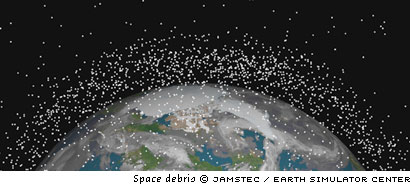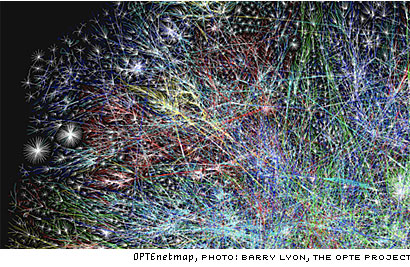The first time I saw a makeshift store take up gallery space at the end of an exhibit, I thought it was utterly bizarre. I have now come to expect it. This one contains a variety of gadgets and souvenirs. Things like the wind-up radio, batteryless flashlight (you shake it for power), and bags made from used juice containers (handmade by women in the Phillipines, and graphically striking enough that I almost bought one) were nice, simple items easily linked to a potential theme of ecologically sound gadgetry and reuse of materials. There was also a bemusing array of Frank Gehry paraphernalia, an “Antiquarium” to observe ants living in gel (don’t ask), and a variety of cheap, plastic cameras presumably as a tie-in to the “image economies”.
I spent quite a bit of time examining the souvenirs. The posters are printed on an unknown coated paper and sported no recycling logos. The t-shirts are 100% cotton, American Apparel brand (but did you know you can get organic cotton t-shirts?, I certainly would have taken it that step further). There is also a Bruce Mau, sortof “signature” set of plates, bowls and cups with various statistical information graphically represented on them. They are all plastic, and I searched in vain for any information at all on what kind of plastic, or how they might have been manufactured. They sported no recycled or recycling logos, but they were made in China.

After coming to the very end of the exhibit it occurred to me that there was a major slice of life missing: art. It seems ironic that a man and a program from a field so closely related to the arts should so “forget” the influence that art has on our lives as humans. Surely technological design has influenced both the expression and the access we have to art? Surely art has informed the big picture design in the “spin on”/”spin off” relationship explored in the military economies? But as I tried to fit this into the model I realized at last that Massive Change is primarily about the design of technological devices, systems and processes, which, when you come right down to it, is a pretty narrow definition of design.
Setting aside my scepticism regarding the hubris of Man, and the unwise, wholesale acceptance of science, I have to ask one very basic question:
What is the purpose of this project and does the exhibit further that purpose?
The Director of the Vancouver Art Gallery, Kathleen Bartels, says, “Massive Change invites us to consider the dramatic impact of design on the world around us and the monumental way that it is changing the way we live.” The poster for the show says “It’s not about the world of design, it’s about the design of the world.” That’s a fairly indiscriminate statement. It doesn’t allude to the betterment of humanity, or the planet. If that’s the premise, then anything goes. But the Massive Change website says “We explore paradigm-shifting events, ideas and people …” OH! Why didn’t you say so before? Suddenly everything shifts into place: biotechnology, Aerogel, Walmart, flourescent paint, ants living in gel, Super Soaker weapons of mass destruction. They all fit.
The subtitle, or tagline, of Massive Change is “Now that we can do anything, what will we do?” That sentence provides the egocentric (from a human species perspective) view of the world that has caused me some grief with the project. But the exhibit adequately showcases a range of technologies both existing and in development. With show and tell as a goal, and “the design of the world” as a subject, Massive Change has succeeded. I learned many things, and most of them were interesting on one level or another.
There was an emphasis on sustainability in most of the displays, leading me to believe that this was part of their agenda, but if so, it was unarticulated as any form of goal either in the wall text or the press material I received from the gallery, so I’m uncertain whether persuasion was part of their intent.
In some ways, the whole thing reminded me of David Suzuki’s TV program “The Nature of Things” which has a long history of examining science and technology and its impact on humanity (with an increasingly political/ecological bent over the past 10 years.) Massive Change is more celebratory and more narrowly focussed on technology, but the goal to inform, inspire and provoke seems the same. I just think “The Nature of Things” does it better, and, over decades, through a highly accessible medium (TV), it has been widely influencial and at times controversial.

The word “manifesto” has been bandied about in relation to this project, and that is another way to look at it. The subtitles for each section say things like:
“We will bring energy to the world”
“We will build a global mind”
“We will eliminate the need for raw material and banish all waste”
“We will eradicate poverty”
(I remember some of those from the exhibit, but not others.)
These are sentiments that are hard to argue with as ideals. And if all students of design were raised with these goals in mind, who knows, the world might indeed change. But building utopian fantasies is easy, dealing with real world situations is hard and often requires harder questions than I believe were asked in this exhibit.
In some of the comments to Massive Post Part 1, Part 2 and Part 3, some people were suspicious of Bruce Mau’s motives. I am not. I really think he means well; I really think he hopes for a better world; I have no objection to him using his status to further that goal. But I still think he deserves a slap for some of the shortfalls and disconnects that turned up in Massive Change.
The Institute without Boundaries “aims to produce a new breed of designer, one who is, in the words of Buckminster Fuller, ‘a synthesis of artist, inventor, mechanic, objective economist, and evolutionary strategist.’”
That Massive Change is a student project is perhaps the most under-stated aspect of the show, but I can’t help but wonder if it holds the key to some of the inconsistencies. Was the variation in perceived intent, as well as the display materials, due to different student interpretations and executions of a theme? I don’t know if each student commandeered a section, but in retrospect it sure seemed that way. In many ways it would be much easier to judge this as a graduate project.
As for the exhibit display itself, from the press kit I received, Bruce Grenville, Senior Curator at the VAG says, “The exhibition reveals Bruce Mau’s visionary artistry; the physical experience will immerse visitors in a series of powerful, poetic encounters to reveal Massive Change at work in our world.” From this standpoint I have to assert that Massive Change achieves none of the above. The irony is that in our traditional understanding of “design,” with those goals in mind, the exhibit is largely a disappointment. I have used this term “exhibit” throughout, and despite aggressive editing in an attempt to reduce the repetitive use of the word, the fact remains that an exhibit is all this is, in a very predictable series of displays. The only physical experience was the one I described while sitting 15 feet from a 50-foot long video display. The interactivity was minimal and gratuitous. It was not immersive, and the poetic moments were rare.
I took some time to observe other visitors in the gallery. They wandered, hands-behind-backs, looking briefly, reading the 12-inch-high* type, but not the rest, listening to parts of one or two of the video displays, then leaving them rambling to no one. They looked interested, but overwhelmed. They seemed unmoved or, at best, puzzled. People who were together seemed to be talking about other things, not the exhibit. I saw no-one laugh or argue. I’m sorry that I was too shy to ask them what they thought.

Massive Change is certainly massive**, but is there change in the way Lester B. Pearson meant when he said,
When we view Massive Change we put on our rose coloured glasses and examine a narrow thread of optimism which is, in itself, tarnished in places. In order to achieve such lofty goals it may be that we each must individually focus on our own lives, our neighbourhoods, our spheres of influence, our specific skills. As designers you may laud Bruce Mau’s interest in expanding the definition of design. Expansive behaviour can be good, but so also is focus. If it makes you feel good to think that as a designer you are part of something bigger, so be it; provided you actually are.
As for Bruce Mau, I think he’s doing what he can, and you have to hand it to him for that. If I met him, I think I would like him, and then I think we might fight—we just view the world differently, is all.
::
*I did promise you a note on the type. I have to say that Impact, set at an approximately 12-inch cap height (I should have taken a pica ruler, but I didn’t know I’d need it, so all measurements are guesses, from memory), in black on white walls is absolutely stunning: it lives up to its name. It is somewhat less effective when used for single-paragraph text at approx 600pt. I have to say, however that it is a poor choice for large chunks of explanatory text, set at approx 400/420 on walls or 60/66 on display cards (my size guesses getting pretty wild, here). It’s difficult to read and headache-inducing. I don’t recommend it.
**There is also Massive Change, the book; Massive Change, the website; and, coming soon to a theatre near you, Massive Change, the feature movie—hopefully at iMax.
Read Part 1 of Massive Post or Part 2 or Part 3






Marian,
If you ever get tired of doing design, you'd make an excellent journalist. Thanks so much for such an even-handed critique and overview of the Massive Change exhibit. I have enjoyed the exhibit vicariously through your words and will seek it out if it ever gets close to my neighborhood.
Despite my own cynicism about Bruce Mau, I do believe that he truly believes in what he's doing and that his motives, in the end are more pure than I would have suggested previously. But, just like you, I think my view of the world is far different then Mau's and I like it that way. But if I was in Mau's place, I think I would do the same as he has, in trying to impact the world around him in a positive way and highlighting design.
It is sad that many of the details that could have made this exhibit true unto itself, were overlooked or ignored. It seems a bit of a shame that despite all the work and research that went into this, what's trying to be communicated gets lost. And if people are leaving the museum puzzled or just plain bored, that is not the kind of design I would encourage. And clearly, Massive Change, lofty as it may be, does not paint a complete picture of the design'r role as a social force.
On Oct.20.2004 at 09:54 AM